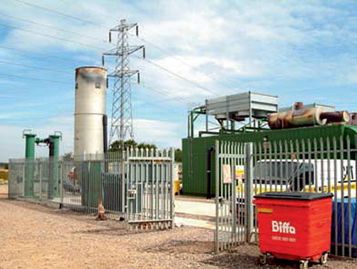Cat system turns landfill gas into electricity
Power Need
Unlike other greenhouse gases, CH4 is an abundant and readily available renewable energy source. It is also a primary constituent of natural gas and is therefore an important energy component.
Over the years landfill wastes will produce large quantities of CH4 due to the biological degradation of the many types of organic materials incorporated in the landfill. Elimination of CH4 is environmentally friendly, as it recovers the negative effects of harmful gasses. A large amount of waste turns into useful electricity. As a result, efforts to utilize methane emissions can provide significant energy, economic and environmental benefits.
In an effort to reduce greenhouse gasses, governments around the world are encouraging projects that turn landfill gas into electricity to try to reduce emissions by implementing cost-effective management methods and technologies. The UK government has set a target for 20% of their electricity to be generated from renewable sources by 2020.
In addition to power, heat was required to warm the leachate lagoon in order to accelerate the biological activity that hastens the breakdown of the leachate.
This 6-MW landfill installation enabled the customer to turn a waste gas into rich fuel and sellable electrical energy.
Solution
Five Cat® generator sets with low energy fuel packages run at the Biffa Poplars Landfill site in Cannock (20km north of Birmingham), UK. The five generator sets run 24/7 and produce about 6 MW of electric power in 70-80% load capacity.
Three Cat G3516LE generator sets were installed in 2003, rated at 1100kW, continuous power each. Two years later, the generation extended to include two Cat G3520C generator sets, to produce 1950kW of continuous power each. This 20-cylinder engine provides even higher levels of efficiency than its predecessors, with electrical convention rates exceeding 40%.
The CH4 gas can be recovered by drilling wells and installing perforated piping. A compressor provides a slight vacuum to draw gas from the field and the positive pressure required to force the gas through the gas processing equipment to the engine. It can then be pumped out, filtered to remove particles and as much water as possible.
The installed generation uses 3000 cubic meters per hour of landfill gas, which contain a minimum methane number of 140. The power plant exports electricity into the National Grid that would otherwise be wasted through flaring. Gas is extracted through 20 manifolds. This landfill continues in use today.
In addition to generating electricity, hot water from the engines' cooling jacket is deployed to heat the leachate lagoon. Generally methane is produced for 20-25 years. The heat quickens the speed to convert waste into gas.
The continuous power site (8000 hours per year) is monitored 24/7 by the continuously manned remote monitoring station at the local dealer site. Each generator set has one individual controller in its own container. A controller incorporates a processor, power organizer and load sharing module, and I/O in one unit. A gas engine controller provides full-featured engine management and control functions, purge cycle, staged shutdown logic, plus programmable protective relaying functions.
Results
The environmental advantages from collecting and utilizing CH4 as a power generation fuel have contributed to reduction of hazardous gas emissions to the atmosphere.
With careful landfill gas collection management, a gas of stable methane content with the range of 50-55% methane can be obtained for the best engine operation results. This landfill site succeeds with around 55% pure methane.
The presence of silicon in the gas creates ash build-up with the combustion chamber. Filters with high effectiveness of particles 1 micron and larger are installed. Even with the filtration equipment, significant amounts of silicon can still enter. Therefore, weekly gas monitoring, which involves analyzing engine oil, is required to indicate levels of silicon in the engine.
The emission levels for NOx are reduced at a given exhaust oxygen level due to the high concentrations of CO2 (35-45%). The CO2 has a high specific heat, cooling the combustion process. The temperature combustion reduces the peak cylinder pressure, thereby reducing production of NOx. The power plant's emissions are well below the maximum standard level, 500 mg per cubic meter.
The transformation of domestic waste into a valuable commercial product is a necessity today. The power plant project is expected to improve methane gas ventilation at the landfill site, while providing an environmentally friendly fuel source to generate electricity. Over some years of operation, high levels of reliability have been experienced. The power plant has resulted in social ecological and economic benefits for the customer.
